A great big blind spot worldwide is carcinogenic cooking oils: Soybean, Corn, Canola, Cottonseed, Safflower, Grapeseed, Sunflower, Rice Bran, and Peanut oil. These toxic seed oils, sometimes innocently marketed as “vegetable” or “refined oils”, are some of the most poisonous ingredients in the modern human diet, increasing your risk of Cancer, Diabetes, and Heart Disease. The problem is, these inexpensive oils are used in almost all restaurants and prepared foods, but few people understand the danger. This article by Dr. Joseph Mercola gives it to us straight. Excerpts from the article and Dr. Mercola’s words follow:
“Many people think it’s sugar, but I believe this health bomb is far worse. If you consume more than 5 grams of toxic linoleic acid from seed oils each day, you could be giving chronic diseases like obesity, heart disease, and tumors a head start in your body. It’s in everything you eat, but especially processed foods.”
LINOLEIC ACID is the BIGGEST TOXIN and BIGGEST Blind Spot in our understanding of foods worldwide. Millions of people buy these cheap, tasteless, easy oils, and then wonder why they feel terrible and die of cancer.
TAKE-AWAY
- Fats are the primary building block of your brain cells and all cell membranes. This is one of the reasons why using the right types of oil is so important for your health and longevity. Do you trust your life to modern refined GMO oils invented by the food industry?
- Experts blame the epidemic of chronic disease on sugar consumption. But the role of sugar is relatively minor when compared to the deadly impact of seed oils.
- We’re talking about the most carcinogenic food in the world. Avoid all seed oils especially Soy oil, Corn oil, Canola Oil, Cottonseed, Safflower, Sunflower, Grapeseed, Rice Bran Oil, Peanut Oil, and Olive oil that’s secretly blended with cheaper oils. Avoid all genetically modified oils.
- Instead enjoy these GOOD Oils low in Linoleic Acid, like
– Coconut oil is the best by far.
– Palm oil is one to the BEST, but gets a bad rep due to marketing hype from GMO oil producers.
– Butter
– Ghee
– Mustard Seed oil
– Avocado oil
– Avoid commercial Olive Oil, as it is mostly mixed with cheaper seed oils. - Sadly, seed oils are widespread in restaurants, processed, prepared foods, salad dressings, and fast food. You risk your life to consume these foods.
- Really, it’s better to pay a little bit more for your food and enjoy a longer life. What do you think?
Cancer and Heart disease are two of the primary killers in the Western world, and Linoleic Acid (LA) is a significant contributor to both of these lethal conditions. One of the first things that happens in atherosclerosis, the precursor to heart disease, is that your macrophages (a type of white blood cell) turn into foam cells — essentially stuffed with fat and cholesterol.
Arterial plaque is basically dead cells loaded with cholesterol and fat. This is why heart disease is blamed on saturated fat and cholesterol. However, researchers have found that for foam cells to form, the LDL (low density lipoprotein cholesterol) must be oxidized, and that is precisely what seed oils do.
Seed oils cause the LDL to oxidize, thereby forming foam cells. So, LDL in and of itself does not initiate heart disease. LDL’s susceptibility to this oxidative process is controlled by the Linoleic Acid content of your diet. Excess seed oils and PUFAs also make cell membranes more fragile, allowing them to be easily damaged by oxidation.
Seed oils are also a major contributor to cancer. In fact, a surefire way to induce cancer in many animal models is to feed them seed oils. Animals typically develop cancer once the Linoleic Acid in their diet reaches 4% to 10% of their energy intake.
And, as mentioned, most Americans get approximately 25% of their total daily calories from seed oils, so we’re far over the safety threshold for these fats — at least based on the laboratory work in animals. Remember our ancestors typically got less than 2% of their calories in the form of these oils.
Studies show that eliminating seed oils from your diet will dramatically reduce your risk of sunburn and lower your risk of skin cancer, because susceptibility to UV radiation damage is controlled by how much Linoleic Acid (LA) is in your diet.
The video above reviews the health risks associated with vegetable oils and seed oils, which are found in most processed foods. It shows how chronic diseases such as heart disease began to skyrocket after the introduction of these oils to the market.
Before 1866, the Western world for the most part only consumed animal fats. Tallow, suet, lard and butter are examples of these fats. Eastern societies used cold-pressed fats like coconut and palm oil. Vegetable oils like we know them today simply did not exist.
The single-greatest change to the human diet in all of history was the introduction of industrially processed seed oils around 1866.8 At that time Procter & Gamble used a newly invented hydrogenation process to convert surplus unusable cotton seeds into a synthetic seed oil, sold to this day under the name Crisco.
Shortly after that, margarine, which is made from seed oils, was introduced. In recent years the company has largely converted to using palm, soy and canola oil for its Crisco, but cottonseed oil is still very much in use for cooking, especially in restaurants for their fryers.9
Historically, we can see that seed oil use increased from approximately 2 grams per day in 1865, to 5 grams per day in 1909, to 18 grams a day in 1999. As of 2008, the average consumption was 29 grams a day. In terms of percentages, seed oils accounted for approximately 1/100th of total calories in 1865 and increased to more than 1/4th of total calories by 2010 — a 25-fold increase!
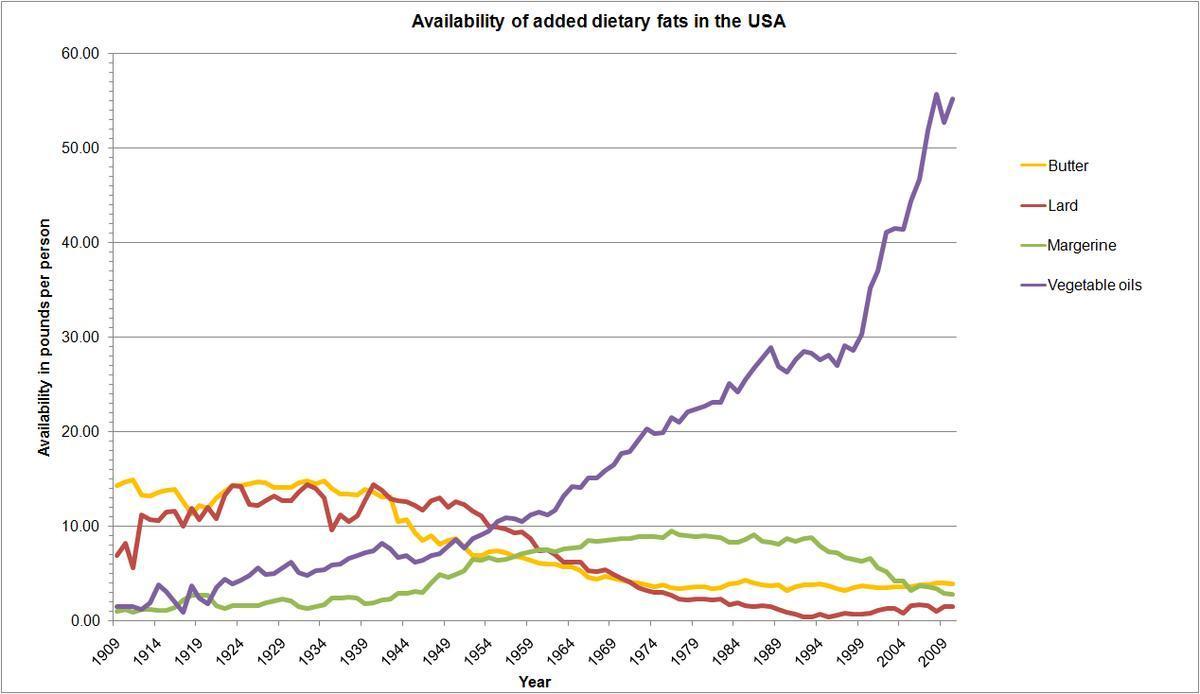
Vegetable Oil Consumption in the USA has skyrocketed since the 1960’s, a very recent addition to the human diet.
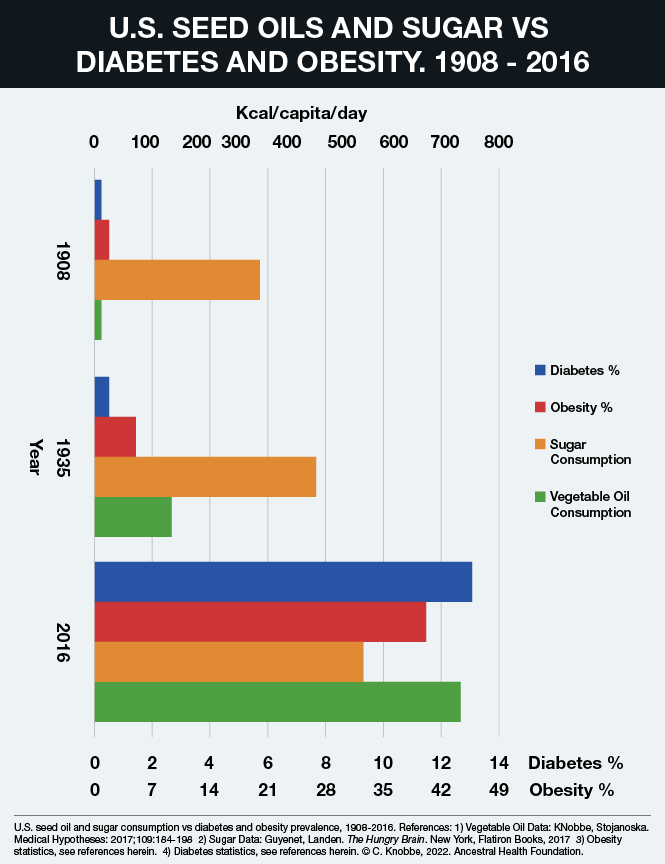
The above chart shows the dramatic increase in cancer and diabetes follows the increase in vegetable oil consumption, which is a more powerful factor than sugar!
What Foods to Avoid, and How
Primary sources of Linoleic Acid (LA) include seed oils used in cooking, processed foods and restaurant foods made with seed oils, condiments, seeds and nuts, most olive oils and avocado oils (due to the high prevalence of blending with cheaper seed oils), and animal foods raised on grains such as conventional chicken and pork.
Anything over 10 grams of LA per day is likely to cause problems. Healthy fat replacements include tallow, butter or ghee, all of which are excellent for cooking.
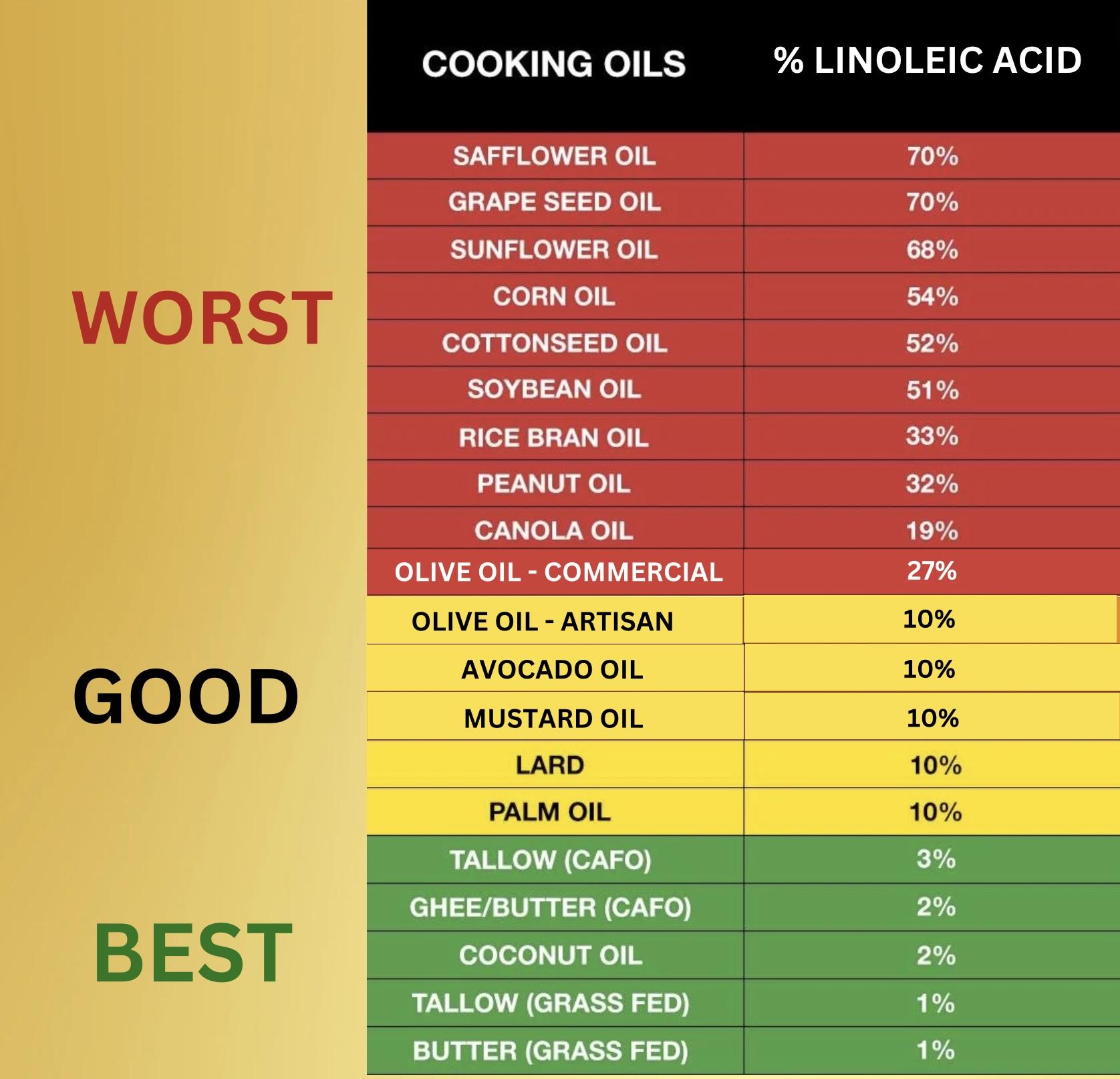
The table above provides a fairly comprehensive list of the most commonly consumed oils and their approximate Linoleic Acid content. The lowest LA-containing fats — butter and beef tallow — would be the fats of choice.
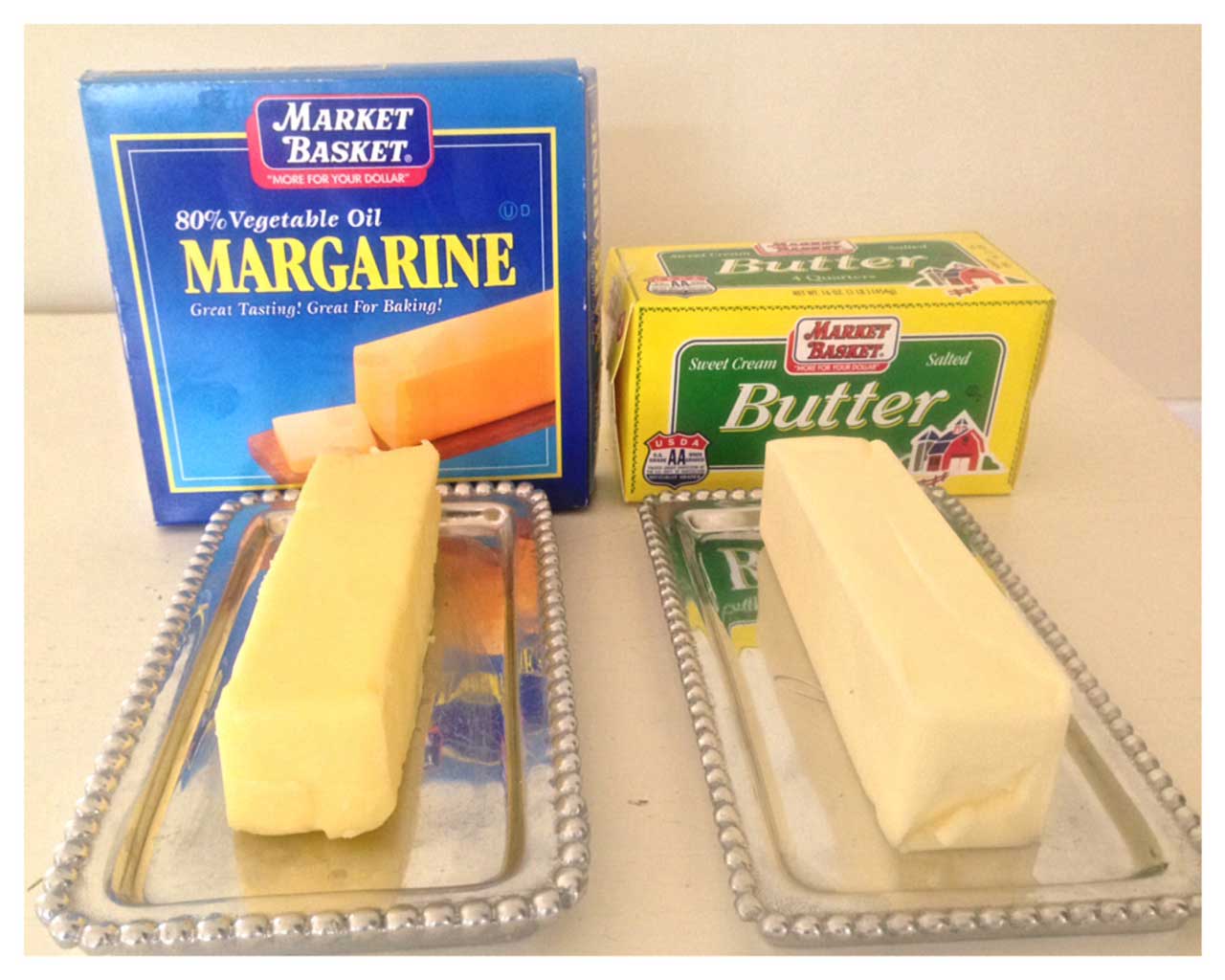 Oh dear, do I need to tell you again? DON’T EAT MARGARINE! Margarine is primarily made up from vegetable oils, which could mean anything like GMO soybean oil, canola oil, corn oil, sunflower oil or one of many other vegetable oil derivations.
Oh dear, do I need to tell you again? DON’T EAT MARGARINE! Margarine is primarily made up from vegetable oils, which could mean anything like GMO soybean oil, canola oil, corn oil, sunflower oil or one of many other vegetable oil derivations.
Vegetable oils are predominantly made up of polyunsaturated fats, also known as PUFA’s. These types of fats are easily oxidised (through heat and light) and oxidised PUFA’s have been shown to cause A LOT of health problems when ingested. I explore this problem in depth in my article PUFA’s: The Worst Thing For Your Health That You Eat Everyday.
Vegetable oils are high in the omega 6 form of PUFA’s linked to all sorts of illnesses such as cardiovascular disease, diabetes, obesity, cancer, IBS and arthritis.
I highly recommend you read the entire article by Dr. Mercola, especially if you want to learn the chemical basis of oils. Here’s the link below:
Linoleic Acid — The Most Destructive Ingredient in Your Diet https://articles.mercola.com/sites/articles/archive/2023/07/17/linoleic-acid.aspx
 Jane Barthelemy is a medical intuitive, author, and healer. She has her MBA in financial management and has practiced Tibetan Buddhist meditation for over five decades, residing in the Rudrananda Ashram in the USA for 35 years. She practices kinesiology, craniosacral therapy, Acunect, and BodyTalk – an infusion of Chinese – Ayurvedic wisdom. She teaches Qigong, Taichi, Daoist sexuality, and Kundalini activation. Her medical Qigong training is with Mantak Chia, Khamto Lee, Daniel Villasenor, Zhongxian Wu, Dr. Ka’imi Pilipovich, Franco Mescola, Richard Leirer, and Lam Kam Chueng. She has her BS in Italian Opera and MBA. Her two paradigm-changing cookbooks show how to build health with unprocessed foods. Her upcoming books include: “Heal Your Past Lives”, and “Buddha Speaks – Channeled Passages from the Master”. She is on the faculty of NewEarth University and LearnDesk. Her websites are FiveSeasonsMedicine.com and JanesHealthyKitchen.com. Jane lives in Bali with her Bhutanese husband, Lama D.
Jane Barthelemy is a medical intuitive, author, and healer. She has her MBA in financial management and has practiced Tibetan Buddhist meditation for over five decades, residing in the Rudrananda Ashram in the USA for 35 years. She practices kinesiology, craniosacral therapy, Acunect, and BodyTalk – an infusion of Chinese – Ayurvedic wisdom. She teaches Qigong, Taichi, Daoist sexuality, and Kundalini activation. Her medical Qigong training is with Mantak Chia, Khamto Lee, Daniel Villasenor, Zhongxian Wu, Dr. Ka’imi Pilipovich, Franco Mescola, Richard Leirer, and Lam Kam Chueng. She has her BS in Italian Opera and MBA. Her two paradigm-changing cookbooks show how to build health with unprocessed foods. Her upcoming books include: “Heal Your Past Lives”, and “Buddha Speaks – Channeled Passages from the Master”. She is on the faculty of NewEarth University and LearnDesk. Her websites are FiveSeasonsMedicine.com and JanesHealthyKitchen.com. Jane lives in Bali with her Bhutanese husband, Lama D.


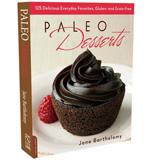

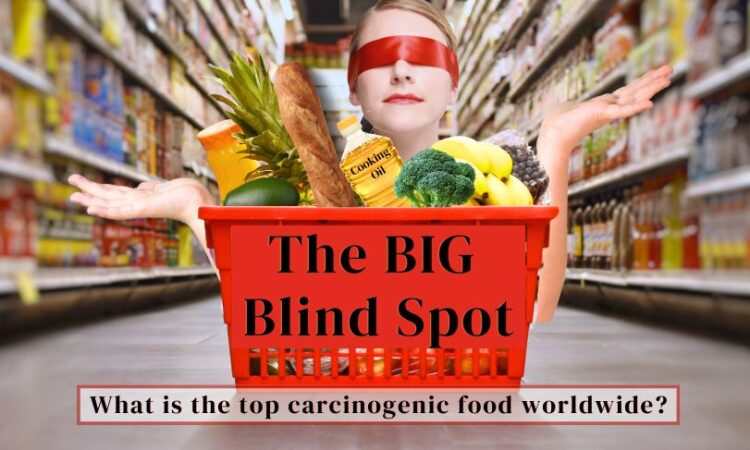
No Replies to "The BIG Blind Spot - What is the top carcinogenic food worldwide?"